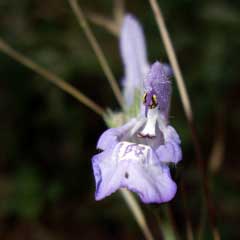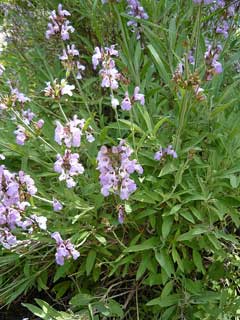 |
|
www.flickr.com/photos/79667341@N00 |
 |
| http://commons.wikimedia.org/wiki/User:Cillas |
Translate this page:
Summary
Physical Characteristics

 Salvia_lavandulifolia is an evergreen Shrub growing to 0.3 m (1ft) by 0.5 m (1ft 8in).
Salvia_lavandulifolia is an evergreen Shrub growing to 0.3 m (1ft) by 0.5 m (1ft 8in).
See above for USDA hardiness. It is hardy to UK zone 5. It is in leaf all year, in flower in July. The species is hermaphrodite (has both male and female organs) and is pollinated by Insects.
Suitable for: light (sandy) and medium (loamy) soils and prefers well-drained soil. Suitable pH: mildly acid, neutral and basic (mildly alkaline) soils. It cannot grow in the shade. It prefers dry or moist soil.
UK Hardiness Map
US Hardiness Map
Synonyms
S. hispanorum. Lag.
Plant Habitats
Edible Uses
The aromatic leaves are used as an adulterant for the common sage[177, 183]. They are used as a substitute for sage in commercial food flavourings[238]. A sage-like tea is made from the dried leaves[238]. The plant is a source of an essential oil that is used commercially to flavour ice cream, sweets, baked goods, chewing gum, soft drinks etc[183, 238].
References More on Edible Uses
Medicinal Uses
Plants For A Future can not take any responsibility for any adverse effects from the use of plants. Always seek advice from a professional before using a plant medicinally.
The leaves are alterative, antiseptic, astringent, depurative, digestive, expectorant, febrifuge and tonic[238]. They are used internally in the treatment of digestive and respiratory complaints, menstrual problems, infertility, nervous tension and depression[238]. This remedy should not be prescribed to pregnant women[238]. The leaves can be harvested as required and used fresh, or they can be harvested before the flowers open and dried or distilled for their essential oil[238].
References More on Medicinal Uses
The Bookshop: Edible Plant Books
Our Latest books on Perennial Plants For Food Forests and Permaculture Gardens in paperback or digital formats.

Edible Tropical Plants
Food Forest Plants for Hotter Conditions: 250+ Plants For Tropical Food Forests & Permaculture Gardens.
More

Edible Temperate Plants
Plants for Your Food Forest: 500 Plants for Temperate Food Forests & Permaculture Gardens.
More

More Books
PFAF have eight books available in paperback and digital formats. Browse the shop for more information.
Shop Now
Other Uses
The essential oil obtained from the leaves is used in perfumery and to perfume soaps and cosmetics[238].
Special Uses
References More on Other Uses
Cultivation details
Requires a light well-drained soil in a sunny position[182, 200]. Soils rich in nitrogen encourage excessive leaf growth at the expense of flowering[11]. This species is not hardy in the colder areas of the country, it tolerates temperatures down to between -5 and -10°c[200]. It is as hardy as common sage, S. officinalis[182], to which it is closely related[11]. Plants can be killed by excessive winter wet[200]. The leaves have a pungent lavender scent[182]. Members of this genus are rarely if ever troubled by browsing deer[233].
References Carbon Farming Information and Carbon Sequestration Information
Temperature Converter
Type a value in the Celsius field to convert the value to Fahrenheit:
Fahrenheit:
The PFAF Bookshop
Plants For A Future have a number of books available in paperback and digital form. Book titles include Edible Plants, Edible Perennials, Edible Trees,Edible Shrubs, Woodland Gardening, and Temperate Food Forest Plants. Our new book is Food Forest Plants For Hotter Conditions (Tropical and Sub-Tropical).
Shop Now
Plant Propagation
Seed - sow March/April in a greenhouse[200]. Germination usually takes place within 2 weeks. Prick out the seedlings into individual pots when they are large enough to handle and plant them out in early summer. In areas where the plant is towards the limits of its hardiness, it is best to grow the plants on in a greenhouse for their first winter and plant them out in late spring of the following year. Cuttings of half-ripe wood succeed at almost any time in the growing season[200].
Other Names
If available other names are mentioned here
Native Plant Search
Search over 900 plants ideal for food forests and permaculture gardens. Filter to search native plants to your area. The plants selected are the plants in our book 'Plants For Your Food Forest: 500 Plants for Temperate Food Forests and Permaculture Gardens, as well as plants chosen for our forthcoming related books for Tropical/Hot Wet Climates and Mediterranean/Hot Dry Climates. Native Plant Search
Found In
Countries where the plant has been found are listed here if the information is available
Weed Potential
Right plant wrong place. We are currently updating this section.
Please note that a plant may be invasive in one area but may not in your area so it’s worth checking.
Conservation Status
IUCN Red List of Threatened Plants Status :

Growth: S = slow M = medium F = fast. Soil: L = light (sandy) M = medium H = heavy (clay). pH: A = acid N = neutral B = basic (alkaline). Shade: F = full shade S = semi-shade N = no shade. Moisture: D = dry M = Moist We = wet Wa = water.

Expert comment
Author
Vahl.
Botanical References
1150200
Links / References
For a list of references used on this page please go here
Readers comment
© 2010, Plants For A Future. Plants For A Future is a charitable company limited by guarantee, registered in England and Wales. Charity No. 1057719, Company No. 3204567.